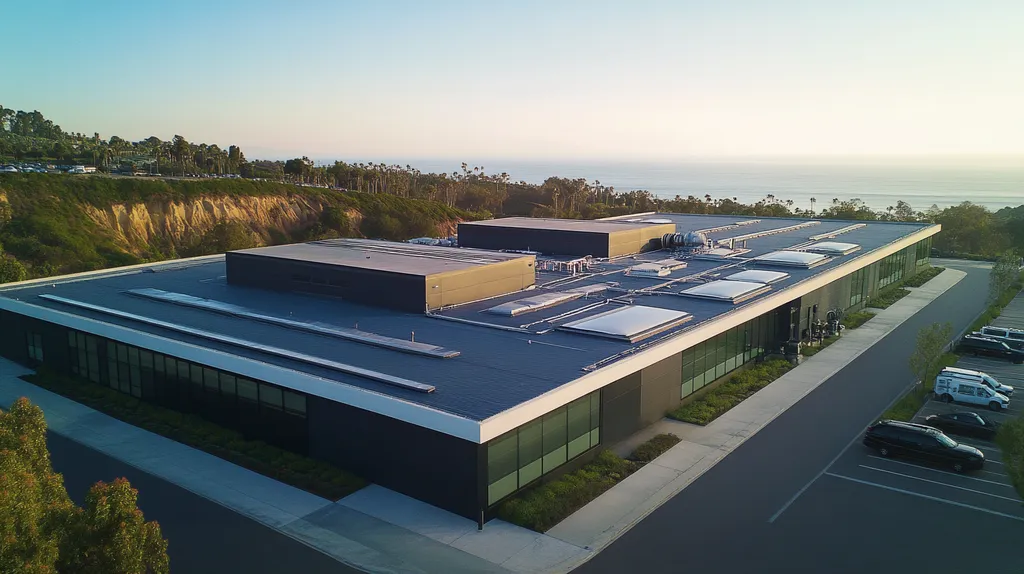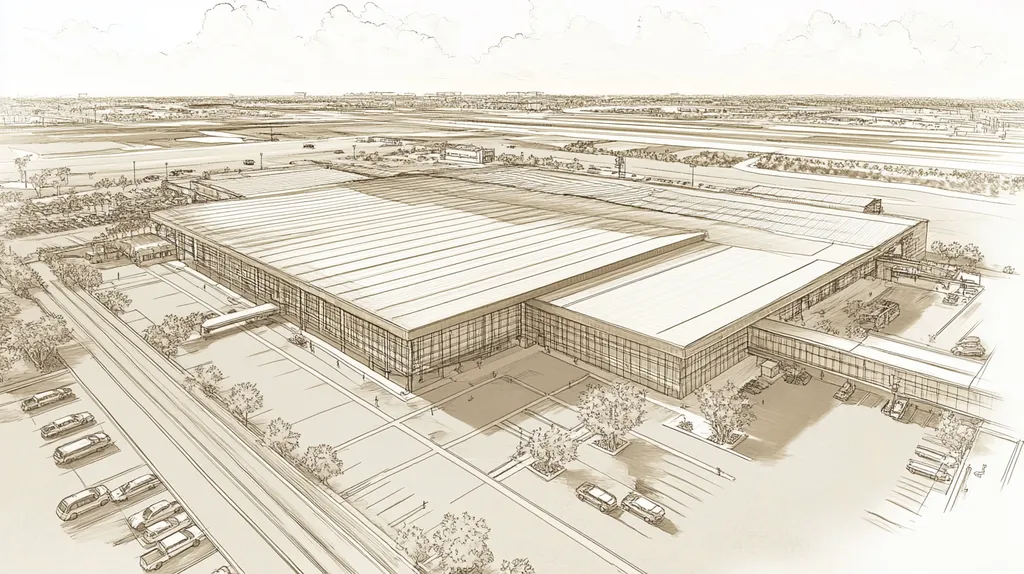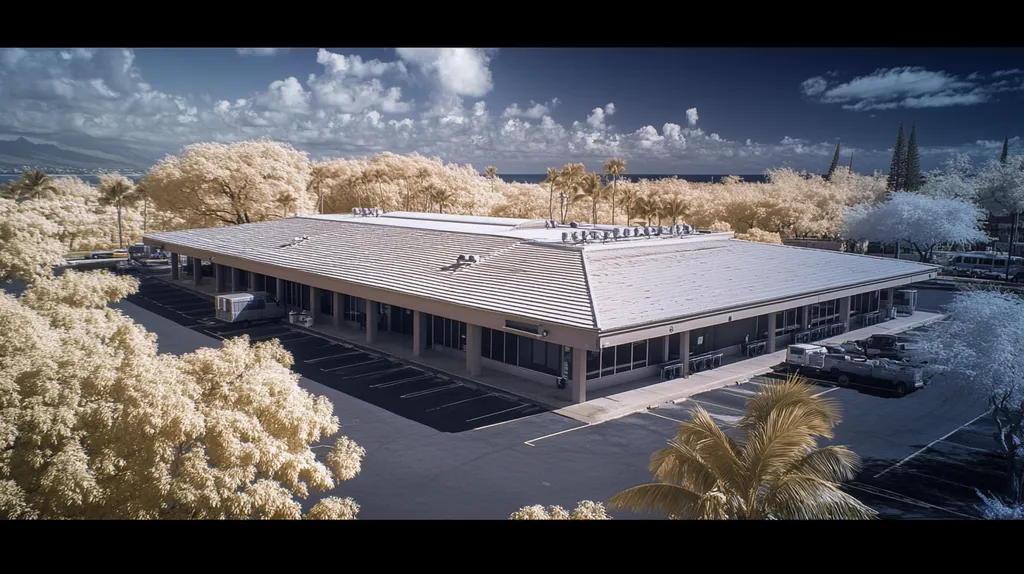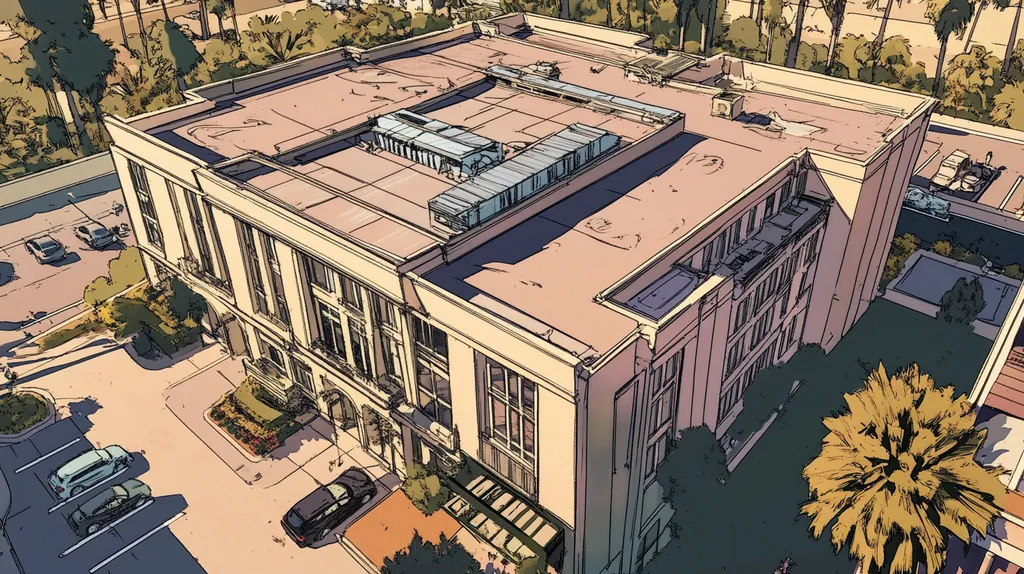In an era where commercial buildings face unprecedented environmental challenges, cutting-edge roof coating technology has emerged as a critical defense against premature roof failure. Industry data shows that 40% of commercial roofs require replacement before their intended lifespan due to inadequate protection.
The latest innovations in industrial roof coatings offer remarkable advances in durability, energy efficiency, and environmental performance. From nano-engineered materials to smart coating systems that adapt to weather conditions, these technologies are revolutionizing how facilities protect their most vital asset.
This comprehensive guide examines the transformative developments in coating technology, exploring how these innovations tackle persistent roofing challenges while delivering substantial returns on investment.
SECTION 1: THE BASICS EXPLAINED
As industrial buildings age, their roofs bear the brunt of relentless exposure to harsh weather and environmental factors. The National Roofing Contractors Association highlights that deferred roof maintenance can spiral into expensive long-term damage, leading to critical leaks and unsafe working conditions. For property owners and facility managers, grasping roof coating technology is not just beneficial—it’s essential for maximizing durability and performance. This section unpacks the fundamentals of roof coatings, shedding light on their significance and functionality.
What It Is (In Plain Language)
Roof coatings are specialized materials applied directly to roof surfaces to boost their lifespan and provide robust protection against the elements. Commonly formulated from acrylic, silicone, or polyurethane, these coatings create a tough, weather-resistant barrier. This innovative technology is compatible with a range of roofing systems, including metal, single-ply membranes, and built-up roofs.
But roof coatings do more than just protect; they also enhance energy efficiency. A quality coating reflects UV rays, cutting down on heat absorption and lowering cooling costs significantly. This means that roof coatings deliver both immediate and long-term financial benefits for building owners.
By investing in roof coatings, property owners can dramatically extend their roofs’ life spans. Understanding their application and benefits is key to making informed decisions that protect valuable assets.
In summary, roof coatings offer a practical and effective solution for maintaining and improving the performance of commercial roofs, making them an increasingly favored choice in the field.
Why It Matters (To Your Building)
Investing in roof coatings is vital for safeguarding a building’s most delicate area. Roofs are continuously subjected to sunlight, rain, snow, and wind, which can lead to significant deterioration over time. Inadequate protection can result in severe damage, driving up repair costs to alarming levels.
Additionally, roof coatings play a crucial role in energy efficiency, especially in today’s economy. With energy prices steadily rising, reflective coatings provide an effective strategy to reduce cooling expenses by lowering heat transfer. This technology translates not just to cost savings, but also contributes to environmental sustainability through decreased energy consumption.
Moreover, regular maintenance complemented by advanced coatings can help prevent water damage and leaks, protecting the building’s interior. By understanding these risks and available solutions, property owners can safeguard their investments effectively.
Ultimately, roof coatings are essential for extending roof longevity, enhancing energy efficiency, and minimizing repair expenditures. For facility managers committed to maintaining high-performance buildings, this investment is indispensable.
How It Works
Roof coatings function by establishing a seamless, waterproof layer over the roofing surface. This protective layer seals small cracks and prevents moisture penetration, which can result in structural damage. The application process typically involves cleaning the roof thoroughly, addressing any existing issues, and applying the coating evenly.
Once set, the coating adheres securely to the roofing substrate, creating a strong bond that enhances the roof’s structural integrity. Different types of coatings present unique advantages, such as greater flexibility, UV stability, and resistance to chemicals, providing tailored protection for specific roofing systems.
While some coatings can be effectively applied in a single coat, others may require multiple layers to maximize their impact. The application technique varies based on the roofing type and the challenges it faces.
Many of today’s modern coatings are also environmentally friendly, containing low levels of volatile organic compounds. This aspect not only contributes to healthier indoor air quality but also ensures high performance.
In summary, the true value of roof coatings lies in their capacity to protect, insulate, and enhance the roof, delivering substantial returns on investment for property owners.
SECTION 2: PRACTICAL APPLICATIONS
For commercial property owners and facility managers, understanding the practical applications of industrial roof coating technology is not just useful—it’s imperative. As extreme weather events become more frequent, aging roofs face heightened risks that demand innovative solutions. Research shows that nearly 30% of flat roofs fail prematurely, leading to costly repairs and operational interruptions. By adopting advanced roof coating technologies, property managers can significantly enhance durability and performance, protecting their valuable investments.
Common Uses & Examples
Industrial roof coatings are versatile and increasingly favored for flat or low-slope roofs. Reflective coatings, for example, can combat heat absorption and reduce energy costs by up to 20% for large facilities. Coatings with elastomeric properties create a robust shield against UV damage and water infiltration, extending roof life significantly.
Take polyurea coatings, which are ideal for manufacturing plants due to their rapid curing times and unmatched durability. These coatings form seamless barriers that prevent leaks and withstand harsh industrial conditions.
Another great option is high-performance silicone coatings, commonly used in warehouses for their exceptional flexibility and ponding water resistance. This proactive approach results in lower maintenance costs and enhanced energy efficiency.
In essence, leveraging these advanced coating technologies can lead to substantial long-term savings and a boost in operational performance for industrial facilities.
When You Need It Most
Identifying the right moment to apply roof coatings is essential for maximizing their benefits. Buildings located in areas prone to severe weather, such as heavy rainfall or snow, should consider coatings to reinforce their roofs against potential water intrusion. Data indicates that roofs subjected to extreme temperature swings are particularly at risk, highlighting the necessity of protective coatings for longevity.
Routine inspections are critical; visible signs of wear—like blistering or cracking—should trigger immediate coating applications. Tackling these issues before they escalate can save property owners from costly repairs and unexpected roof failures.
The age of the existing roofing material also plays a vital role. Roofs older than 10-15 years significantly benefit from timely coatings, extending their functional lifespan and overall performance.
Understanding when to implement roof coating applications can yield considerable benefits and ensure that safety standards are met consistently.
Interactions With Other Systems
Integrating roof coatings with existing systems can significantly elevate overall building performance. Many coatings work harmoniously with insulation systems, boosting thermal efficiency. This synergy not only reduces energy consumption but also enhances indoor comfort levels.
Coatings can also positively interact with drainage systems. Properly applied coatings can help channel water away from critical areas, mitigating the risk of leaks and ponding. Collaborating with roofing professionals to guarantee compatibility is essential.
Additionally, certain roof coatings can complement green roofing systems, allowing for vegetation growth. This combination promotes sustainability and efficiently manages stormwater runoff.
Overall, recognizing how roof coatings interact with other building systems can unlock further efficiencies, enhancing protection and preserving the building’s value.
SECTION 3: KEY TERMINOLOGY DECODED
The roofing industry is evolving at a breakneck pace, making it vital for property owners and facility managers to familiarize themselves with essential terminology. Key terms related to roof coating technology can often appear intimidating, yet understanding them is crucial for effective decision-making. For example, knowing the difference between “elastomeric” and “acrylic” can significantly influence project outcomes. This section will clarify key concepts, demystify industry jargon, and break down measurements to enhance comprehension.
Essential Terms Explained
“Roof coating” refers to a protective layer applied to existing roofs, enhancing their durability and lifespan. Not all coatings are equal; some excel in UV protection while others focus on waterproofing. Distinguishing between these types helps property owners make informed choices that suit their needs.
Another important term is “reflectivity,” which measures how well a roofing surface reflects sunlight. High reflectivity can result in significant energy savings by keeping buildings cooler, while low reflectivity may lead to increased heating costs, especially in warmer climates.
Lastly, “thickness” refers to the coating’s depth, which directly impacts the roof’s durability and performance. A thicker coating generally offers superior protection but may increase costs. Finding the right balance between thickness and budget is critical for effective roofing solutions.
Industry Jargon Translated
The roofing industry is rich in jargon that can confound even experienced property managers. Terms like “RTU” or “retrofit” describe specific processes that are essential to understand. “RTU” stands for rooftop unit, indicating a type of heating and cooling system commonly located on roofs. Knowing this helps in choosing appropriate coatings that can withstand mechanical wear.
“Retrofit” involves adding components to an existing roofing system without the need for complete replacement. This can include applying a new coating to boost performance, making it essential for cost-effective upgrades.
Another familiar term is “sealant,” which refers to substances used to fill gaps and seams in roofing systems. Understanding where and when to apply sealants can substantially improve a roof’s resistance to water infiltration.
Lastly, “leak barrier” describes materials specifically designed to prevent water penetration. Familiarity with this terminology aids property owners in implementing effective preventive measures during coating applications.
Measurement & Units Simplified
Navigating measurements in roofing may seem complex, yet they are crucial for accurate evaluations. A “square” is a standard unit in roofing that covers an area of 100 square feet. Grasping this measurement is essential for estimating material quantities needed for a project.
“Mils” measure the thickness of coatings, with one mil equivalent to one-thousandth of an inch. Knowing the required mil thickness ensures that the correct product is applied for long-lasting durability.
The “elongation” percentage is also a key metric, indicating a coating’s ability to stretch without tearing. A high elongation rate is especially beneficial in regions with fluctuating temperatures.
Lastly, “permeance” measures how easily moisture can pass through a roofing material. Understanding this property helps choose coatings that are best suited for local climate conditions.
SECTION 4: DECISION FACTORS
Making informed decisions about roof coatings is crucial for optimizing investments and ensuring peak performance. Alarmingly, an estimated 30% of roof failures can be attributed to inadequate coatings, leading to unwarranted financial losses and operational setbacks. It’s essential for property owners and facility managers to fully grasp the dynamics of cost, performance, and durability when selecting the right coating technology. This section explores these critical decision factors, equipping decision-makers with the knowledge they need.
Cost Considerations
Cost is usually top of mind when evaluating roof coatings, but it’s vital to look beyond the initial expense. Prices for materials and installation can vary dramatically. While certain coatings may seem budget-friendly at first glance, they could incur higher long-term costs through maintenance and premature replacements.
Evaluating the total cost of ownership over the life of the coating is paramount. For example, investing in high-performance coatings may come with a heftier price tag upfront, but these coatings often extend roof life and lower energy bills, proving to be a smarter investment over time.
Moreover, some financing options and incentives for eco-friendly coatings exist. Various states provide rebates for energy-efficient upgrades, making it wise for property owners to explore local financial programs that can help mitigate initial costs.
Lastly, don’t overlook labor expenses tied to preparation and application. Complex roofing systems could necessitate specialized labor, which raises installation costs. It’s crucial to weigh these costs against the expected performance benefits.
Performance Trade-offs
Performance characteristics must align closely with the specific needs of each facility, highlighting the importance of understanding potential trade-offs. For instance, some coatings exhibit exceptional heat reflectivity, which significantly reduces cooling costs in warmer climates, while others focus solely on delivering maximum durability in extreme weather conditions.
Understanding the roof’s operating environment is critical. A rooftop in a coastal area, for example, will need a coating that can withstand saltwater corrosion, while an industrial facility may require a formulation tailored to resist harsh chemicals.
Consideration of the application process is equally important. Certain advanced coatings might require extensive surface preparation and have prolonged curing times, which can disrupt productivity during installation. The ideal coating should align with the overall operational requirements of the facility.
Finally, performance expectations should be inclusive of warranties and manufacturer claims, ensuring that facility managers are not left in the dark about product capabilities.
Lifespan & Durability Factors
The lifespan of a roof coating plays a crucial role in its long-term value. High-quality options can dramatically increase a roof’s lifespan, protecting against significant repair expenses. For instance, elastomeric coatings can endure for 10 to 20 years when proper maintenance is followed, displaying remarkable resistance against UV rays and thermal shock.
Property owners need to scrutinize the durability of available options, especially in relation to environmental factors like temperature swings and rainfall, as these can impact long-term performance. Selecting coatings engineered for resilience in specific climates is essential.
Another crucial consideration is performance degradation over time. Some coatings may initially perform well but could flake or chalk as they age. Wisely choosing a coating with a successful performance track record alleviates concerns about its efficacy in the future.
Finally, instituting a regular maintenance regimen will help maximize the lifespan of coatings. Facility managers should establish a routine that includes inspections, cleaning, and touch-up applications to keep coatings functioning optimally.
SECTION 5: COMMON CHALLENGES
Industrial roof coatings, while essential for protecting valuable assets, are not without their challenges. Property owners and facility managers frequently encounter issues like premature wear, adhesion failures, and the effects of environmental factors. Understanding these challenges is critical; unresolved problems can lead to skyrocketing repair costs, decreased energy efficiency, and even structural damage. This section examines common issues, vital warning signs, and proactive strategies to optimize roof coating performance and lifespan.
Frequent Problems & Solutions
One prevalent issue is the premature wear of coatings. Extreme weather conditions and intense UV exposure can accelerate the degradation process. Conducting regular inspections is key to catching such damage early, allowing for timely maintenance that can significantly extend the life of the coating.
Inadequate adhesion between the coating and the substrate poses another challenge. This problem often arises from surface contamination or improper application techniques. Ensuring a meticulously cleaned and primed surface before application is crucial to overcoming this hurdle.
Environmental factors such as moisture and temperature fluctuations can also disrupt roof coating performance. To counter these risks, utilizing high-quality materials specifically designed to endure local climate conditions is essential, thus enhancing overall durability.
Lastly, drainage issues can lead to standing water on coated roofs, creating a perfect environment for mold and mildew development. Regular maintenance, combined with effective drainage solutions, is vital to mitigate these risks and ensure a longer lifespan for the roof coating.
Warning Signs To Watch For
Vigilance is your ally when it comes to spotting potential coating failures. Look out for blisters or bubbles appearing under the coating—these can indicate moisture entrapment. Early detection is critical; addressing these signs promptly can avert extensive damage.
Visible cracking or peeling is another alarming indicator, signaling that the coating may have lost its adhesive properties due to poor installation or age. Implementing regular visual checks can help catch these issues before they escalate into costly repairs.
Discoloration of the coating is also a significant warning sign. Fading or chalking often points to UV damage and diminished protective qualities. Monitoring the roof’s appearance can serve as a clear reflection of its functional performance.
Additonally, leaking or water infiltration signs around roof edges may suggest problems with the coating system. Immediate action is essential when leaks are observed, as they can lead to expensive interior damages.
Preventative Approaches
Prevention is the cornerstone of maintaining effective industrial roof coatings. One crucial tactic is to conduct routine inspections and maintenance. These practices can help identify potential problems before they escalate into costly repairs.
Establishing a regular cleaning schedule can further enhance coating performance. By eliminating debris and contaminants from the roof surface, property owners can improve adhesion and reduce the likelihood of premature wear.
Selecting the appropriate coating materials for specific roof types and environmental conditions is equally important. Collaboration with roofing professionals can lead to tailored solutions that address unique facility needs effectively.
Finally, investing in employee training on proper application techniques can significantly diminish the chance of adhesion failures and fatigue. Informed staff ensures that the roof coating accomplishes its protective role effectively and efficiently.
SECTION 6: NEXT STEPS & RESOURCES
As the field of industrial roofing undergoes remarkable innovations, ensuring that property owners and facility managers stay ahead is paramount. With over 50% of commercial roofs facing serious issues within the first two decades, it is vital to make informed decisions swiftly. By knowing the right questions to ask, understanding industry standards, and accessing valuable resources, decision-makers can protect their roofs effectively for the long haul.
Questions To Ask Providers
Property owners should approach roofing providers armed with crucial questions that delve into both product quality and application practices. Inquire about the specific types of coatings they utilize and how these materials perform over time. Request data on their resistance capabilities against UV damage, puncturing, and various weather conditions to gain insight into product longevity.
Another essential consideration involves warranty specifics. Confirm the length and coverage offered, especially during extreme weather events. Understanding the maintenance requirements is equally crucial—ask whether the upkeep fits within your operational budget for sustainable planning.
Reviewing the provider’s track record is vital. Ask for case studies or testimonials from facilities similar to yours to evaluate their reliability and expertise. A contractor with demonstrated success can dramatically influence your roofing investment’s lifespan and performance.
Lastly, stay informed on the latest technological advancements in roof coatings. Questions about how the provider integrates cutting-edge innovations into their offerings will not only help you make informed choices but also ensure that your roofing solution is aligned with current best practices.
Industry Standards & Guidelines
Adhering to industry standards is not just good practice—it’s essential for ensuring that roofing solutions meet safety, efficiency, and performance criteria. Organizations such as the American Society for Testing and Materials (ASTM) provide crucial guidelines for various roofing materials, including roof coatings.
Familiarize yourself with the installation, maintenance, and inspection standards set forth by the National Roofing Contractors Association (NRCA). This knowledge will empower property owners to adopt methods that enhance roof longevity and mitigate common issues that can lead to costly, premature failures.
Additionally, tapping into guidelines from the Cool Roof Rating Council (CRRC) offers valuable insights into reflectivity and emissivity. With both factors playing vital roles in energy efficiency, understanding these ratings can help you select coatings that lower energy costs while contributing to sustainability goals.
Compliance with these standards not only guarantees safety but can also elevate the value and efficiency of your building. When properly understood and implemented, these industry guidelines pave the way for successful roofing projects.
Further Learning Simplified
To enhance knowledge about roof coating technology, various resources are readily available. Online platforms featuring webinars and tutorials present complex concepts in an easily digestible format, making learning more accessible for busy professionals. Many organizations offer free or low-cost courses focused specifically on roofing solutions.
Staying engaged with industry publications and blogs allows property owners to remain updated on new trends and findings. By subscribing to these resources, you can track market shifts and adapt to the latest innovations with ease.
Participation in trade shows and conferences provides valuable opportunities for networking and insight-sharing. Connecting with industry experts and peers can reveal effective strategies for managing roofing projects, broadening your perspective on what’s possible.
Finally, leveraging online forums and social media groups fosters a community-oriented approach to discussing emerging technologies and best practices. Engaging with these platforms enriches decision-making capabilities and strengthens long-term planning efforts.
Looking Ahead
The rapid evolution of industrial roof coating technology represents a critical inflection point for commercial property protection, with research indicating that advanced coatings can extend roof life by up to 25 years while reducing energy costs by 30%.
As extreme weather events increase in frequency and intensity, the role of innovative coating solutions becomes increasingly vital for protecting billions in commercial assets.
Smart coatings, nano-engineered materials, and AI-driven application systems are poised to transform how facilities defend against environmental threats.
Property owners who embrace these emerging technologies position themselves to dramatically reduce maintenance costs, enhance building performance, and future-proof their facilities against escalating climate challenges.
The future of industrial roofing lies not just in protection, but in intelligent, adaptive systems that actively preserve and enhance building value.
FREQUENTLY ASKED QUESTIONS
Q. What are the basics of commercial roof coatings?
A. Roof coatings are materials applied directly to roofs to enhance their lifespan and protect against harsh elements. Formulated from acrylic, silicone, or polyurethane, these coatings create a resilient barrier. They not only safeguard but also improve energy efficiency by reflecting UV rays, leading to lower cooling costs and extending roof life significantly.
Q. What are the practical applications of industrial roof coatings?
A. Industrial roof coatings are essential for flat or low-slope roofs, tackling heat absorption and preventing leaks. Reflective coatings lower energy costs, while elastomeric options provide protection against UV damage. Rapid-curing polyurea coatings are perfect for facilities, ensuring durability in demanding conditions and significantly extending roof life.
Q. What key terms should I know about commercial roof technologies?
A. Understanding terms like “roof coating,” “reflectivity,” and “adhesion” is vital. A roof coating improves durability, while reflectivity measures how well a surface reflects sunlight, impacting energy costs. Adhesion indicates how well a coating bonds to the roof, which is crucial for the coating’s longevity and effectiveness.
Q. What decision factors are important for industrial roof coatings?
A. Critical factors include cost, performance, and durability. It’s essential to consider total ownership costs, as high-performance coatings may incur greater upfront costs but offer long-term savings. Assessing the coating’s suitability for your building’s specific environment is equally important for ensuring lasting effectiveness.
Q. What common challenges do commercial roof coatings face?
A. Common challenges include premature wear, poor adhesion, and environmental impacts. Regular inspections help identify wear or peeling before they worsen. Choosing high-quality coatings designed for specific climates is critical to counteract degradation from temperature fluctuations and moisture, ensuring optimal roof performance.
Q. What next steps should I take for industrial roof maintenance?
A. Begin by asking roofing providers essential questions about materials and their performance. Familiarize yourself with industry standards from organizations like ASTM and NRCA to ensure compliance. Consider furthering your knowledge through online resources, webinars, and industry events to stay updated on innovative technologies and best practices.
Q. How do eco-friendly options impact industrial roof performance?
A. Eco-friendly coatings significantly enhance a roof’s energy efficiency and longevity. These options often reflect more sunlight, leading to lower cooling costs. Additionally, many contain fewer volatile organic compounds, promoting better indoor air quality while ensuring durability and minimizing environmental impact during application and throughout their lifespan.











